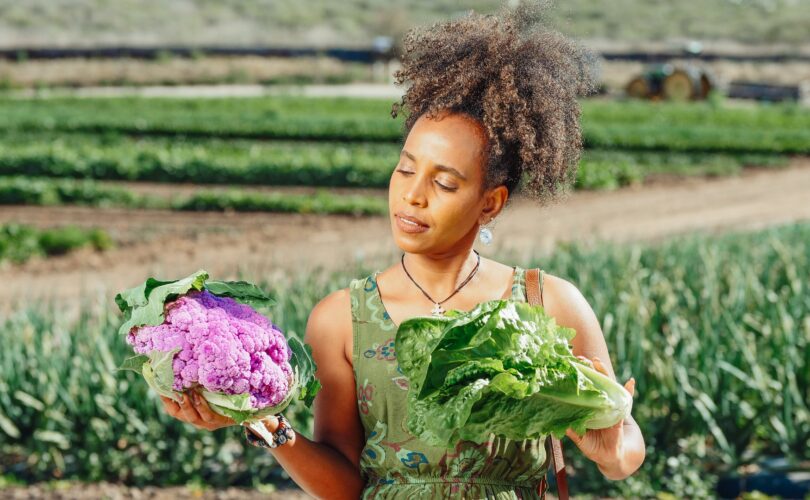Organic food is becoming more popular in the UK, as consumers seek to buy products that are better for their health and the environment. But what is organic food, and how does it differ from conventional food? How does the demand and supply of organic food affect the market? How does the quality of organic food compare to non-organic food in terms of yield and nutrient profile? I am a fan of organic food, for a few reasons; they don’t have pesticide and herbicide residues, farming methods are more sustainable meaning especially when it comes to soil health, they are better for our environment, they taste better, although I accept this could be considered personal and most importantly they tend to have a higher nutrient density. On the other side of the argument, commercial producers maintain crop yields are not good enough, although some research is beginning to challenge that, more later.
What is organic food?
Organic food is the product of a farming system that avoids the use of synthetic fertilisers, pesticides, growth regulators, antibiotics, hormones and genetically modified organisms (GMOs). Organic farming relies on natural methods of production, such as crop rotation, composting, biological pest control and animal welfare. Organic food must meet strict standards and regulations, and be certified by an approved organic control body, such as the Soil Association1. Organic food can be identified by the green leaf logo on the packaging, which indicates compliance with the EU Organic Regulation2.
For a food product to be labelled as organic, it has to meet the following standards and requirements:
- At least 95% of the agricultural ingredients have to be organic
- The non-organic ingredients have to be approved by the organic regulation and not contain any artificial colours, flavours, sweeteners or GMOs
- The production, processing, storage, packaging and transportation of the organic food have to avoid any contamination or mixing with non-organic products
- The organic food has to be certified by an approved organic control body, such as the Soil Association, which carries out regular inspections and audits to ensure compliance with the organic standards and regulations
- The organic food has to display the organic logo, the name of the organic control body, and the code of the country where the agricultural ingredients were produced18
How does the quality of organic food compare to non-organic food in terms of yield and nutrient profile?
One of the main arguments against organic food is that it has lower yields than conventional food, and therefore it is less efficient and productive. However, this argument is based on a narrow and biased view of yield, which does not take into account the environmental and social costs and benefits of different farming systems. A more holistic and comprehensive approach to yield would consider the impacts of farming on soil health, biodiversity, water quality, climate change, animal welfare, human health and food security10.
Soil erosion and exhaustion are significant environmental concerns in the United Kingdom, impacting both agricultural productivity and environmental sustainability. Soil erosion occurs when the top layer of fertile soil is worn away due to factors like water, wind, and unsustainable farming practices. This erosion leads to soil exhaustion, where the remaining soil lacks essential nutrients needed for healthy crop growth. As a result, farmers often turn to synthetic fertilisers to compensate for the nutrient deficit, leading to a cycle of dependency that can have long-term detrimental effects.
According to a recent meta-analysis, the yield gap between organic and conventional farming is lower than previously thought, and it varies depending on the crop type, the region, and the management practices. The study found that the average yield gap was 19.2%, but it could be reduced to 8-9% if organic farmers used more diversified cropping systems, such as multi-cropping and crop rotations, which can enhance soil fertility, pest control and water use efficiency. Moreover, the study noted that organic farming has the potential to increase yields in low-input and marginal areas, where conventional farming is not viable or sustainable11.
Another common argument against organic food is that it has no nutritional advantage over conventional food, and therefore it is not worth the higher price. However, this argument is based on a limited and outdated evidence base, which does not reflect the current state of knowledge and research on organic food quality. A more recent and rigorous review of the literature has found that organic food has higher levels of nutrients than conventional food, especially antioxidants, vitamin C, nitrates and some polyphenols. The review also found that organic food has lower levels of pesticide residues, heavy metals and antibiotic-resistant bacteria, which can pose health risks to consumers12.
Examples of everyday staples that have higher nutrient levels in organic than conventional versions are:
- Milk: Organic milk has higher levels of omega-3 fatty acids, which are beneficial for cardiovascular and brain health, and lower levels of omega-6 fatty acids, which can promote inflammation. Organic milk also has higher levels of vitamin E, iron and carotenoids, which are antioxidants that protect against oxidative stress13. For those readers who know my story anything natural that boosts Omega 3 content is a good thing
- Bread: Organic bread is made from organic flour, which has higher levels of protein, minerals and antioxidants than conventional flour. Organic bread also has lower levels of mycotoxins, which are toxic substances produced by fungi that can contaminate grains and cause health problems14.
- Apples: Organic apples have higher levels of phenolic compounds, which are antioxidants that have anti-inflammatory, anti-cancer and anti-diabetic effects. Organic apples also have lower levels of pesticide residues, which can disrupt the endocrine system and affect hormonal balance15.
What types of foods are being organically grown and what standards have to be met for a producer to qualify as an organic producer?
The most commonly purchased organic foods in the UK are fruits, vegetables, grains, dairy products and meat16. However, there are also other types of organic foods available, such as eggs, honey, herbs, spices, oils, drinks, snacks, cereals, pasta, rice, sauces, soups, ready meals, desserts, chocolates, cakes, biscuits, breads, jams, spreads, nuts, seeds, dried fruits, and more
How does the demand and supply of organic food affect the market?
The demand for organic food in the UK has been growing steadily over the years, reaching a record high of £2.79 billion in 2020, an increase of 12.6% from 20193. The main drivers of this growth are the rising consumer awareness of the health and environmental benefits of organic food, the increased availability and accessibility of organic products in supermarkets and online platforms, and the impact of the COVID-19 pandemic, which has boosted the demand for local, ethical and sustainable food 3.
The supply of organic food in the UK, however, has not kept up with the demand, resulting in a trade deficit and a reliance on imports. According to the latest data, the UK had a total area of 507 thousand hectares farmed organically in 2021, up from 489 thousand hectares in 2020, representing 2.9% of the total farmed area4. However, this is still far below the EU average of 8.5%, and the UK ranks 16th among the EU countries in terms of organic land share 5. The main challenges faced by organic farmers in the UK include the high costs of production and certification, the lack of government support and incentives, the competition from cheaper imports, and the uncertainty caused by Brexit 6.
To address these challenges and to increase the supply of organic food in the UK, the industry has launched several initiatives, such as the Organic Action Plan for England, which aims to double the size of the organic market by 2030, and the Organic Trade Board, which promotes the benefits of organic food to consumers and retailers 7&8. Moreover, some supermarkets have been supporting organic food cultivation by offering their own organic ranges, sourcing more organic products from local farmers, and providing organic certification schemes for their suppliers. 9 17.
The conflict between cheap food and effective nutrient acquisition
We’d all love to eat the best food available, but the simple fact is that this is not possible for a significant minority of people in the UK now. I wrote a piece on malnutrition about how it is increasing and another on the science of bliss point foods that are addictive in nature. It seems to me that the principal reason is not so much people are unaware of the potential issues, they are more seduced by the lifestyle and habits they have developed over many years of exposure to convenience and great tasting food. The challenge is that most of us are unaware of the quality and density of the nutrients in what we eat everyday. For most people, including me, the wake up comes when an unanticipated health challenge forces a reevaluation of lifestyle.
References
- – Soil Association: https://www.soilassociation.org/
- – EU Organic Regulation: https://ec.europa.eu/info/food-farming-fisheries/farming/organic-farming/organic-regulation_en
- – Soil Association Organic Market Report 2021: https://www.soilassociation.org/media/21646/soil-association-organic-market-report-2021.pdf
- – Defra Organic Farming Statistics 2021: https://assets.publishing.service.gov.uk/government/uploads/system/uploads/attachment_data/file/1015839/organic-farming-statsnotice-15sep21.pdf
- – Eurostat Organic Farming Statistics 2020: https://ec.europa.eu/eurostat/statistics-explained/index.php?title=Organic_farming_statistics
- – The Guardian: UK organic food market booms during pandemic: https://www.theguardian.com/environment/2021/feb/23/uk-organic-food-market-booms-during-pandemic
- – Organic Action Plan for England: https://www.soilassociation.org/media/21647/organic-action-plan-for-england.pdf
- – Organic Trade Board: https://www.organictradeboard.co.uk/
- – The Grocer: How supermarkets are supporting organic food: https://www.thegrocer.co.uk/organic/how-supermarkets-are-supporting-organic-food/655565.article
- – Nature: Rethinking yield gaps: https://www.nature.com/articles/s41893-020-00631-0
- – Nature Communications: Reducing the yield gap of organic crop production: https://www.nature.com/articles/s41467-020-18451-1
- – British Journal of Nutrition: Higher antioxidant and lower cadmium concentrations and lower incidence of pesticide residues in organically grown crops: a systematic literature review and meta-analyses: https://www.cambridge.org/core/journals/british-journal-of-nutrition/article/higher-antioxidant-and-lower-cadmium-concentrations-and-lower-incidence-of-pesticide-residues-in-organically-grown-crops-a-systematic-literature-review-and-metaanalyses/33F09637EAE6C4ED119E0C4BFFE2D5B1
- – Journal of Dairy Science: A meta-analysis of organic and conventional milk composition: https://www.sciencedirect.com/science/article/abs/pii/S0022030215007129
- – Journal of Cereal Science: Organic versus conventional wheat quality: A systematic review and meta-analysis: https://www.sciencedirect.com/science/article/abs/pii/S0733521017300298
- – Journal of Agricultural and Food Chemistry: Organic versus conventional apples: A comparison of fruit quality parameters and antioxidant capacity: https://pubs.acs.org/doi/abs/10.1021/acs.jafc.9b07144
- – Statista: Most popular organic food categories in the United Kingdom (UK) in 2019: https://www.statista.com/statistics/283523/most-popular-organic-food-categories-in-the-united-kingdom-uk/
- – Organic Food UK: https://www.organicfood.co.uk/
- – GOV.UK: Organic food: how to label and sell it in the UK: https://www.gov.uk/guidance/organic-food-how-to-label-and-sell-it-in-the-uk






